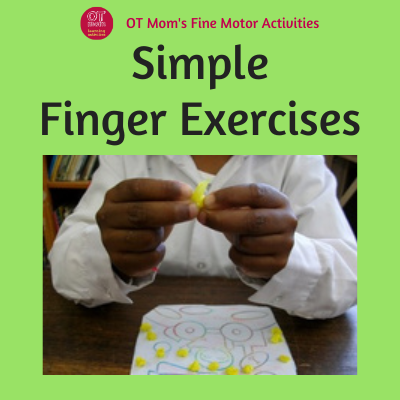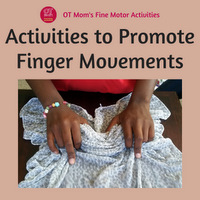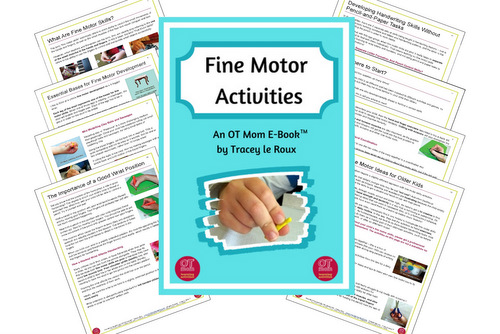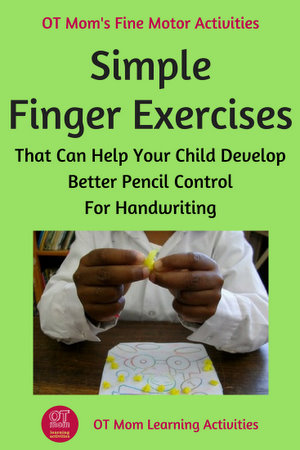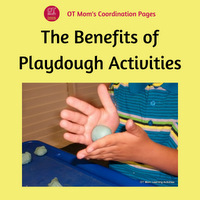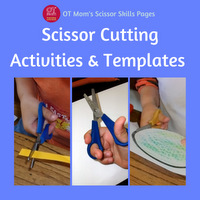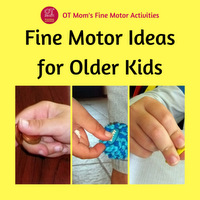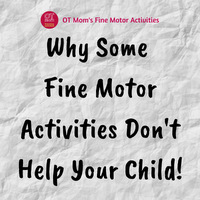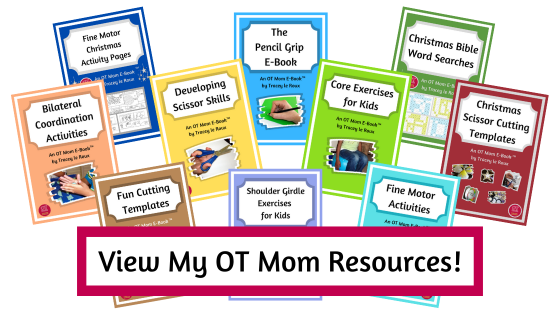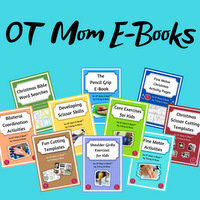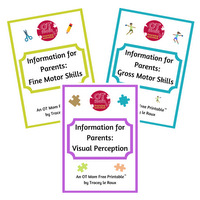- Home Page
- Fine Motor Activities
- Finger Exercises for Kids
Finger Exercises For Kids
These finger exercises for kids are designed to increase the dexterity and skill of the tripod fingers, with the hope of ultimately improving your child's pencil control and handwriting.
These fine motor activities are designed to be easily incorporated into your home routine or classroom activities, using readily available resources.
I sometimes link to products (#Ad) that are similar to those I use and love. If you do purchase something through my links, I will receive a small commission that helps support my site - thank you!
The activity suggestions on this page are designed to promote your child's normal development. If you are at all concerned about your child's development, please consult an occupational therapist. This website is NOT a substitute for occupational therapy evaluation and treatment!
Which Fingers Are These Exercises For?
As you can see from the picture alongside, three fingers: the thumb, index and middle fingers, work together to control the pencil.
This grasp is known as a dynamic tripod pencil grasp, and I refer to these 3 fingers that hold the pencil as the tripod fingers.
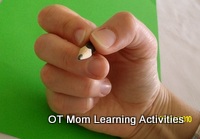 Dynamic Tripod Pencil Grasp
Dynamic Tripod Pencil GraspOnce your child has the hang of getting the tripod fingers to work together, the fingers should be able to move freely and easily in order to control a pencil for flowing handwriting.
Some children have a pencil grip that looks a little different from this - you can take a look at some different functional pencil grasps on this page.
But no matter which grasp your child uses, the fingers need to work together well in order to control the pencil properly, and these finger exercises are designed to help your child improve these skills.
Isolating The Tripod Fingers
In all these finger exercises, your child needs to be able to use the tripod fingers without having the ring and little finger moving. This is called isolating the tripod fingers.
But Why Is This Important?
I need to use some jargon here!
Keeping the ring and little fingers tucked away develops what is called the Distal Transverse Metacarpal Arch (DTM Arch).This is basically the arch formed across the hand by the knuckles - you can see it when you make a fist.
This arch is important as it gives stability to the joints and muscles of the hands while the tripod fingers are moving and thus reduces fatigue during handwriting.
Try writing with your ring and little fingers sticking out a bit, and you can immediately feel the strain on your hand!
The kids whose hands are pictured below have not yet developed this stable arch, and all of them tire easily during handwriting tasks!
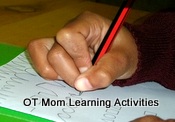 No DTM Arch
No DTM Arch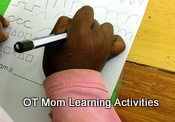 Writing is tiring
Writing is tiring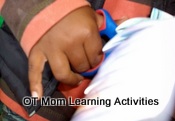 Little finger sticking out
Little finger sticking outHelping Your Child Isolate The Tripod Fingers
When fine motor skills are weak, it may take a child a while to get the hang of moving the tripod fingers on their own.
If your child struggles to keep the ring and little fingers down on a piece of paper, have your child hold down the fingers as shown alongside.
 Idea to develop the DTM arch
Idea to develop the DTM archI usually ask the child to hold a small piece of paper under the ring and little fingers to keep them out of the way.
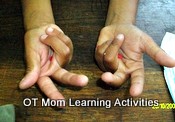 Hold paper under the ring and middle fingers
Hold paper under the ring and middle fingers An activity while the fingers are held out of the way
An activity while the fingers are held out of the wayOk, now onto the fun finger exercises for kids!
1 - Finger Ball Walk
Introduce your child to this activity without using the tripod fingers, until they get the hang of walking the ball up and down their legs. (Or up one leg, across the tummy, and down the other leg!)
Look out for kids making grabbing movements with their hands instead of getting a WALKING movement with their fingers.
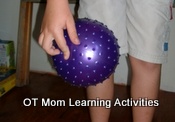 Walking the ball
Walking the ballOnce they have got the hang of walking the ball with their fingers, then isolate the tripod fingers as explained above and try again.
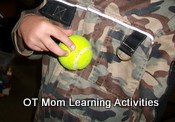 Using tripod fingers to walk the ball up and down the body
Using tripod fingers to walk the ball up and down the body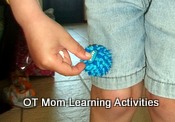 Use just the thumb and index finger for more of a thumb workout
Use just the thumb and index finger for more of a thumb workoutYou can also vary the size and type of ball used.
Walking DOWN the leg takes more control than walking up!
If your child has a "lazy thumb", try using just the thumb and index fingers to walk the ball!
2 - Playdough Finger Exercises for Kids
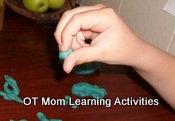 Use the tripod fingers to make a playdough ball
Use the tripod fingers to make a playdough ball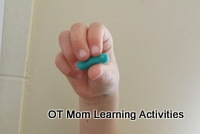 Use the tripod fingers for a playdough sausage
Use the tripod fingers for a playdough sausage A playdough nest with little eggs
A playdough nest with little eggsUse the tripod fingers to roll out small balls with a rolling movement of the fingers and small sausages with a back and forth movement of the fingers. Sausages can be easier than balls at first.
These can be used in many different ways in playdough creations- see my Playdough Activities page for ideas!
3 - Mini Paper Crumpling
This is one of my favorite fine finger movement activities as it is so easy to have a box of different color papers on hand to add a 3D aspect to any picture.
Cut small squares of crepe or tissue paper ahead of time (crepe paper holds its shape better) .
 A box of little paper bits ready for action!
A box of little paper bits ready for action!Give your child one piece of paper at a time to squish a bit as shown, using the tripod fingers of both hands.
Then ask your child to use just the tripod fingers of the dominant hand to one-handedly ROLL the crumpled paper into a smaller, tighter ball.
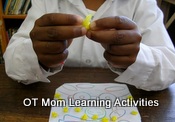 Crumpling mini paper balls
Crumpling mini paper ballsYou can use the balls of crumpled paper to decorate a picture - they make great stars, leaves, or just interesting detail on a regular coloring picture!
More Challenging Finger Activities
If your child enjoyed these fine finger movement exercises, you can try my pencil control exercises and activities to promote finger movements for more of a challenge. These activities can help your child with finger isolation, and to develop more refined finger movements, better in-hand manipulation and better pencil control.
Have fun!
Helping A Child Who Struggles
Please do seek a professional opinion if your child is struggling more than his/her peers.
- If your child is struggling to do these exercises for fingers, then try my simpler hand and finger activities and my hand strengthening exercises for kids.
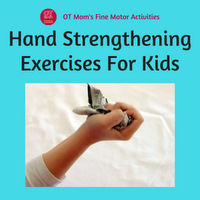 Hand Strength Ideas
Hand Strength Ideas- My OT Mom Fine Motor E-Books are packed full of easy activities like these finger exercises, as well as lots of additional helpful information to help develop your child's fine motor skills.
There are more than 24 pages of fine motor activities designed to be done at home or in the classroom.
- Learning Resources#Ad have created some lovely, appealing toys and games to build fine motor skills. These fun resources are a great way to do finger exercises for kids who otherwise avoid fine motor tasks.
Thank you for visiting my site!
I trust you were helped and inspired by how easy it is to help your child develop the fine motor skills that he/she needs for school!
Why not sign up for my free occasional newsletter to stay in touch with updates to my site?
- Home Page
- Fine Motor Activities
- Finger Exercises for Kids
Share this page to help others!
Pages Related to Finger Exercises for Kids
Didn't find what you were looking for? Try a search of my site!
